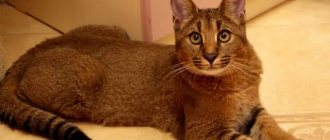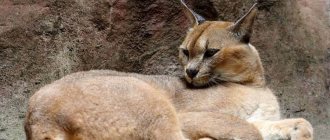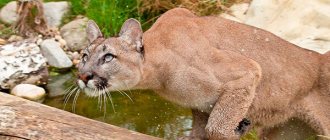The caracal is a wild cat, also known as the steppe lynx. Translated from the Turkic language, caracal means “black ear.” The name speaks for itself; these cats have black backs of their ears. In North Africa, this cat is called the Barbary lynx.
In this article we will tell you: who is a caracal, how much does it cost, how long do caracals live, is it possible to keep them at home, how to care for them, what to feed them, what are the peculiarities of upbringing.
Origin of the breed
At first, caracals were classified as lynxes because of their external similarity, but later scientists discovered some genetic features and identified cats as a separate genus. However, cats are still related to lynxes and have a number of similar characteristics. At the same time, caracals are much closer to pumas in morphological characteristics, and in captivity, black-eared cats are crossed with African servals.
Despite the wild blood, the caracal is easy to tame. He quickly comes into contact with a person and socializes with proper upbringing. In India and Ancient Persia they hunted pheasants, peacocks, hares and antelopes with caracals. The cats were called "little cheetahs" or "poor man's cheetahs" because only wealthy people could afford real cheetahs.
Interesting. Mating a caracal with a domestic cat produces a breed called the caraquet.
In Russia, wild caracals are found in Dagestan. At last count, there were only a few cats left there—about 100 individuals. But given the fact that people still continue the practice of domesticating caracals, cats now live in houses and apartments as pets. Considering the cost of a kitten, which starts from 500 thousand rubles, people with high incomes can buy it.
In nature, there are 9 subspecies of caracal. It is difficult for an ordinary person to notice the differences between them, unlike specialists. African caracals are the most numerous subspecies. Asian cats are critically endangered and are listed as a CITES species. This means that the trade in such animals is tightly controlled. It is impossible to purchase an Asian caracal in licensed Russian nurseries. Breeders are engaged in breeding the domesticated subspecies.
Tame a caracal
Contents hide
Tame a caracal Graceful, magically and exotically beautiful, with an aristocratic appearance, the caracal has become a desirable cat in the homes of those who want to emphasize their social status with a pet or surprise friends and guests. A kitten is an elite pleasure; the price for it is close to half a million rubles. And even if money is not a problem, such a cat will require a lot of effort and endless spending. To give a caracal a happy life in captivity, you need to try very hard.
www.photopin.com
Pointed ears, black regal tassels, sand-colored fur, a sophisticated bright muzzle and increased muscularity... A unique cat requires the right approach and unconditional love, without which it is not possible to care for a caracal for 15 years (which is how long a cat usually lives in captivity).
No matter how you try to raise a kitten to be a domestic pussy with a charming appearance, the wild blood of a predatory mammal will always flow in the caracal’s veins. This means that the conditions of detention should not include a sofa and dry food from the store, but a whole complex, almost like in a zoo. The caracal takes root well in a country house, where you can make a spacious enclosure outside. Since the breed is found in nature in Central Asia and the Middle East, in savannas, deserts and foothills of Africa, the cat is accustomed to a warm climate and will not survive in snowstorms and frosts in an open enclosure without heating. However, inviting a kitten to live at home means losing all pieces of furniture and accessories and jeopardizing the health of young children. The first couple of years of life, the caracal is absolutely unstoppable, very active and can fight back with its powerful muscular paw. Of course, not out of malice, but according to the laws of life of wild cats. The caracal can be tamed and made into an affectionate pet, but it is unlikely to be domesticated.
The best life for a “black ear” (as the word “caracal” is translated from the Turkic) includes the opportunity to run its paws on the ground and smell the fresh air. The cat is extremely smart and, with proper training, will be ready to play with its owner according to his rules. The tame caracal loves to make friends with other pets, especially if it grew up next to them. Offering fish, mice and birds as friends to a cat, you see, is funny and stupid. For thousands of years, the ancestors of the caracal hunted these creatures, and even the most mongrel cat, whose grandfathers have lived with people for almost an eternity, will want to eat the bird.
Due to their external similarity, the caracal has long been classified as a lynx. Later it turned out that the genetic code of the animal has a number of features that make it possible to distinguish it into its own biological genus - caracals. According to morphological characteristics, the cat is close to pumas and servals.
The caracal grows to an impressive size for a domestic cat: the body length usually reaches 85 cm, and the tail - 30 cm (larger than most lynxes) and weighs 25 kg. This means that without game it is difficult to maintain the animal’s health. Tame caracals are fed chicken, beef, rabbits, various rodents, fish and eggs. “Protein is our everything!” - every caracal will tell you so. Veterinarians prohibit the inclusion of pork in the diet of these cats, since it provokes a dangerous disease in caracals.
As for the amount of food, an adult individual daily in quantitative terms consumes about 5% of its own weight. For example, a ten-kilogram male will eat half a kilo of game in a day. Caracals are fed once or twice a day, and the food should not be in the bowl all the time. The meat is served at room temperature. In addition, in the summer, when it’s hot, the cat eats less than in the cold season. An interesting feature: every two weeks the animal is given a fasting day without food, which happens to cats when living in the wild.
Having a caracal is almost like deciding to have a child. This is a creature in which you need to invest both morally and materially, love and respect his nature.
Caracals in the wild
Not everyone knows where the caracal lives, but we will tell you! The natural environment of caracals is savannah, steppe, desert, foothills of Africa, as well as the deserts of the Arabian Peninsula, Asia, and the Middle East. In the CIS, cats are found in the territory of Southern Turkmenistan, the coast of the Caspian Sea, and in the east of Kyrgyzstan. In 2022, employees of the Environmental Protection Agency, which is located in Abu Dhabi, discovered the first caracal for the first time. Before this, the predator had not been seen in the UAE for 35 years.
Caracals are active at night, but in winter and spring they stick out their sensitive noses during the day. As a home, they choose rock crevices and fox holes, in which they live for several years in a row. Males “own” vast territories, females are content with little - they are located on the periphery.
Long legs allow you to quickly gain speed, but do not affect endurance in any way. Caracals cannot run as long as other wild cats can. Therefore, black-eared beauties hunt stealthily: they track the prey and overtake it with long (4-4.5 m in length) jumps. In addition, caracals have lightning-fast reactions and retractable claws that are sharp, like scalpels.
This allows predators to pluck several birds from a flying flock. However, the main diet of caracals consists of jerboas, gerbils, ground squirrels, tolai hares, antelopes, and goitered gazelles. Occasionally cats snack on hedgehogs, porcupines, lizards, insects, foxes, mongooses, and young ostriches. They may also steal poultry, lambs and goats. Caracals are able to live without water for several days, or even weeks, receiving life-giving moisture from food.
Interesting. The caracal hides its prey in the trees, like a leopard.
Nutrition
The caracal is only a carnivorous predator. But their diet depends on where they live. In Africa, these cats can hunt ungulates. In Asia, caracals primarily feed on small birds and rodents. There is many evidence of the beautiful jumps of this cat while catching birds. Caracal has its own record. In one jump, he knocks down up to 12 birds on the fly!
Caracal jumping
An interesting list of this cat's diet:
- Different types of rodents;
- Hares, rabbits;
- Small birds and their eggs;
- Small breeds of monkeys;
- Small antelopes;
- Fleet-footed gazelles;
- Bustards in Africa.
These predators can also catch a reptile. Caracals can with a strong blow deprive a victim of life, which weighs several times more than the hunter himself. Due to the fact that the caracal's hind legs are longer than its front legs, it makes huge leaps and knocks large game to the ground.
Interesting: Leopard - description, range, photos and videos
Caracal - hunting
The caracal climbs trees very well, often storing its prey high on the branches so that it does not fall to numerous predators. This is facilitated by long retractable claws, like those of pets.
Appearance of a caracal
Externally, caracals are similar to lynxes, but they are smaller, look slimmer, and their fur is colored the same tone. Body length 65-82 cm, tail - 25-30 cm, height - 43-45 cm, all - 10-20 kg. The length of the ears with tassels is 4-5 cm. Tufts of coarse hair stick out between the fingers. This makes it easier to move around the sand dunes.
The coat is short and very thick. The main color is sandy or reddish brown. The belly is whitish. There are dark marks on the sides of the muzzle. The tufts and back of the ears are black. There are also blue-black melanistic caracals, but seeing them in their natural habitat is a great success.
Characteristics of the Caracal breed
Caracals stand out from other wild cats with their appearance. A cat that looks like a real desert lynx is the first impression this unusually beautiful animal makes. However, the caracal is not related to the lynx genus and morphologically the breed is more close to the puma.
The paws, thin body and tail are much longer than those of a true lynx, unusually elongated black ears with tassels, as well as a number of genetic differences made it possible to distinguish the caracal into a separate genus. The African serval is also considered close to the caracal family.
To avoid confusion with wild caracals, the breed was given a second name - caraquet , to emphasize the domesticity of cats and their focus on humans.
Breed standard
General characteristics of the Caracal breed:
- Body: developed body of a predator – strong, muscular; the length of males can reach 120 cm, females - 110 cm, the average size of a pet is 70-85 cm. Weight: 10-20 kg. Tail length is from 19 to 35 cm. Height at withers is from 30 to 50 cm. Females are smaller than males.
- Coat: Short, soft and dense, honey brown in color, slightly longer and lighter on the inside.
- Head: Dark spots on both sides of the muzzle, black spots above the eyes and a black stripe from the eye to the nose form a uniform tan or brick red color. The nose is dark.
- Eyes: large, yellow-brown.
- Ears: large, vertically positioned, 4-6 cm long, with a black back and dense long tassels made of hard wool.
- Limbs: long, allowing you to easily jump to a height of up to 3 meters. The forelimbs are longer than the hind limbs. The paws have a dense brush of hard hair, which makes it easier to move through the sand in their natural habitat.
- Lifespan: In a home environment, the caracal lives up to 15 years.
Photos of caracals
Photos of beautiful representatives of the breed:
Health
Caracals, if properly kept, have good health and good immunity. With proper care and quality nutrition, they practically do not get sick. However, these cats are very curious, and can sometimes chew and swallow inedible objects.
Caracals are vaccinated with regular cat vaccines. Life expectancy at home reaches 15 years.
Important! Before purchasing a caracal kitten, be sure to check with reputable veterinarians in your area. This will allow you to quickly resolve issues related to the health and development of your pet.
Character
A well-bred and trained caracal is affectionate and friendly to all household members. He is active, sociable, loves to play. Socialization is one of the most important stages of working with a breed, first for the breeder and then for the owner.
Caracals meow not so often; the main way of communication is hissing and growling in cases of dissatisfaction or uterine rumbling in a complacent mood.
In character, the caracal resembles a cat and a dog at the same time: the gracefulness and curiosity of a cat are mixed with the activity of a puppy. He quickly learns to go for walks on a leash. Educational activities are also a game for him. It is necessary to use various gaming equipment. Pay special attention to games with the ball and suspension.
Attention! Playing with your pet with your hands and feet is strictly prohibited. In a fit of excitement, the animal can damage your limb.
Features of character and behavior
Domestic caracals from an elite nursery are well-bred and, as a rule, do not cause much trouble to their new owners. The menacing appearance and impressive size mislead people; many people think that wild blood certainly affects temperament and character, and that it is almost impossible to control a caracal. In fact, caracals turn out to be absolutely calm, balanced, obedient and friendly animals.
They love and respect their owners, and are always ready to protect them from ill-wishers. Cats are distrustful of strangers. First, they need to sniff the stranger and determine his intentions with an experienced eye. If everything is fine with the guest, the caracal will welcome him on its territory. Owners of the breed note the developed intuition of their pets. Animals immediately determine with what intentions a person has come.
Caracals are playful and active at home. The owner must be on the same level as his ward and get involved in the game on time, otherwise the cat will find something to do with itself. At the same time, there is no need to play the caracal too much, otherwise harmless pranks may end in injury to one or both participants in the game.
Representatives of the breed, like small children, need the care and attention of their “mother.” The owner always plays this role. Cats are easy to raise and train. But if they don’t like something, they can use their claws and teeth. For example, if you see that your pet is tired of playing, leave him alone. He can’t voice his condition, but he can easily paw at him! This is why breeders do not recommend playing with caracals with your hands. Instead, it is better to buy a toy in the form of a pendant at a pet store or make one yourself.
A domestic caracal with a stable psyche does not deliberately show aggression, but families with small children should be careful and not get a cat until the child reaches an age when the rules of handling the steppe lynx can be explained to him.
These animals are smart and quick-witted, quickly accustomed to the tray, come when called, responding to their name, and carry out simple commands.
The steppe lynx gets along well with dogs and other cats, but perceives birds and small animals as prey.
Character and training
When properly raised, the caracal is an intelligent, affectionate, playful animal. Gets along equally well with all family members. Loves communication.
He remembers everything quickly and is easy to learn. In general, the caracal resembles a kitten and a puppy: feline grace and curiosity, the activity of a puppy. He quickly gets used to walking on a leash. Working with an animal is play and education at the same time. Should continue until the pet gets bored. Having played enough, he opens his mouth like a dog. During periods of special affection, he lies down closer to his owners and purrs and “chirps” very beautifully. During entertainment, he gets the greatest pleasure from playing with a ball and a pendant. You cannot play with your pet with your hands or feet.
A properly raised lynx easily adapts to people. The caracal is not only an affectionate friend and an exotic pet, it is also a reliable guard. Unexpected guests are unlikely to come to a country house where such predators live.
Cat breed caracal or steppe lynx
Maintenance and care
If the caracal's habitat is city apartments, walk the cat daily on a leash. Fresh air is vital for him. But breeders still advise owners of private houses to own caracals, because a large animal needs space.
Caracals can be very clumsy. Sometimes the room after games resembles a battlefield: broken vases and flowers, scratched wallpaper and furniture upholstery. If possible, equip a playroom in your home with an area of about 15 square meters. m with various climbing frames, Swedish slides, and a scratching post.
The pet's home should look like an enclosed space with an adjoining enclosure, from which you can go out onto the garden plot. The area of the house must be fenced off so that the cat cannot escape in an unknown direction. Pay attention to the heat-loving nature of caracals. These cats cannot tolerate cold at all, so their home must be heated.
Adult males and females mark territory. Breeders have long come to terms with this, but new owners will have to spay or neuter their pet at 3-5 months if you are not going to breed.
Thick and dense wool with a padded undercoat sheds all year round, and especially heavily in the summer. The pet will have to be combed 3-4 times a week and bathed once every 4-6 months. The caracal grinds its claws down on its own, but you can trim them if you wish. You are taught the procedure from an early age, otherwise you won’t be able to get your hands on a cat later.
Important! Caracals, like many other wild animals, are keenly interested in foreign objects and often try out interesting finds. Therefore, breeders strongly recommend removing objects that the steppe lynx can swallow from the field of view. Often it ends up on the operating table!
Nutrition
Caracals eat three times more than regular house cats. And this is not surprising - just look at the size of the animal! Cats prefer fresh meat from broiler chickens, whole quail carcasses with feathers, beef, turkey, and will not refuse to crunch on rodents. You can give sea fish after removing the bones.
Fresh vegetables are served with meat and fish: zucchini, pumpkin, cabbage, carrots. Fermented milk products and raw eggs are offered 1-2 times a week
Industrial food is not the best food for these animals, even if it is labeled “for large breeds.” Do not feed your domestic lynx lamb and pork. The first is too fatty for him, and eating pork leads to infection with Aujeszky's disease - infectious paralysis or itchy plague. The list of prohibited foods also includes whole milk, soups, table foods and cereals.
The optimal diet for the Caracal cat breed is as follows: kittens - twice a day, adults - once. The amount of food varies depending on the age of the animal, but in any case it should be impressive. Food must be served at the same time. If the cat has not finished eating, the leftovers are thrown away and the bowls are washed. Once a week it is recommended to arrange fasting days. Clean, cool water should always be available! This needs to be monitored as caracals drink a lot.
After the meal, the room will resemble the arena of the Colosseum during a gladiator battle: bones, feathers, blood, meat everywhere. The future owner will have to clean the eating area every day.
Health and how long they live
In-person visits to the veterinarian should be carried out twice a year, and the carcal should be vaccinated against rabies and other dangerous infectious diseases on time. Steppe lynxes have excellent health and rarely get sick, but if your pet still feels unwell, you should not self-medicate. Regular brushing of the coat will help prevent the development of stomach problems. Let us indicate how long caracals live. The average life expectancy is 15-20 years.
Upbringing
Caracals begin to be raised at 3-4 months of age. First of all, your pet needs to be accustomed to the scratching post in order to preserve the furniture and wallpaper.
You need to communicate with the animal every day and not ignore it. Socialization is the most important point in raising representatives of this breed, otherwise wild genes will begin to dominate. Surround your pet lynx with care and love, and he will thank you in kind.
Content Features
Since the caracal is still a wild predatory cat, there are difficulties in keeping it at home, namely:
- You cannot keep this type of cat in an ordinary apartment. You need a lot of space. Optimally - keeping in a private house with a fenced local area.
- To keep the animal outdoors, you will need to build an enclosure to the house - an extension of about 20 m2, with a fence height of 2.5 meters or higher.
- The animal requires active walks and a lot of attention.
- The animal is thermophilic and does not tolerate cold.
- The pet will require high-quality nutrition and care, and accordingly, maintenance costs will be high.
- It is not advisable to have a caracal if children under 5 years old live in the house.
- If there are no plans for breeding, the pet must be sterilized before the age of 8 months, otherwise the animal will leave marks in your house.
- Caracals are difficult to litter train. If you succeeded, then you can proudly consider yourself an excellent trainer.
Care
In the house where the caracal lives, everything should be cleaned as if a curious puppy lives there. The fact is that these cats are very playful, and after their games the house is turned upside down. Everything that can be attributed to a toy in one way or another will be mined, chewed, scratched and even partially eaten.
Games are the basis for the education and socialization of a young individual. Toys must be made of quality materials. Take the ones offered for large dogs.
Big cats love to swim, they swim and happily take water treatments as often as they are offered.
The claws on the paws must be trimmed in a timely manner. There must be a sufficient number of scratching posts in the house, otherwise the furniture will suffer significantly.
Nutrition
Particular attention should be paid to nutrition. As stated earlier, caracals are carnivorous predatory cats that hunt small animals, so they should mainly be fed raw meat. The diet is selected according to the breeder's recommendations.
Can be fed with high quality dry cat food. Nutrition should be balanced. The norm for food consumed per day is about 5% of the cat’s weight.
Attention! It is strictly forbidden to feed pig meat; pork causes Aujeszky's disease, the common name for this disease is “pseudorabies” or itchy plague. This disease almost always leads to the death of the animal. It is also necessary to exclude ready-made dishes “from the table”, spices in any form, salted and smoked foods.
Walking your pet
The domestic caracal needs active, long-term walking. You can use a leash for walking outside. It is advisable to equip a fenced area in the form of an enclosure - an extension to the house in which it is kept.
Breeding
In the wild, caracals breed year-round. The female usually has 2-3 partners. Pregnancy lasts 78-81 days, after which 1 to 6 kittens are born. Over the course of a month, the mother cat changes her den several times. As soon as young caracals turn six months old, they leave their home and go in search of their own. Sexual maturity occurs at 16-18 months. The most suitable age for finding sexual partners is 14-15 months.
Domesticated female caracals also give birth several times a year. However, breeders do not allow their cats to become pregnant more than once a year to maintain their health. Up to four babies are rarely born in a litter, often two.
Lifestyle
Caracal The caracal
is mainly a nocturnal predator. But sometimes he can be found hunting during the day. It is very difficult to spot a caracal during the day. This cat is well camouflaged and senses the approach of people from a distance. She can lie almost motionless for several hours, hiding next to a person.
This cat leads a solitary lifestyle. Males do not stay with the female when she has cubs. Caracals have a large hunting area. They do not allow rivals into their territory, even if they are larger than them. In Africa, caracals are driven out of their range by predators twice their size. Also, these amazing cats can live for a long time without water. They do not suffer from drought. Therefore, during these terrible times for other animals, they, on the contrary, gain weight, as they ambush on trails near small bodies of water. Caracals, like all cats, hiss, meow and growl loudly.
How to choose a kitten
It is recommended to buy a caracal kitten from home-type nurseries. Cats are in constant contact with people and are characterized by the highest level of socialization. However, this does not guarantee that the caracal will be docile and affectionate. And you need to remember this!
The breeder must have a breeding license, the nursery must be clean, the cats must be healthy, each pet must have a package of documents, a veterinary passport, and a CITES certificate. In addition, the buyer signs a purchase and sale agreement, receives an acceptance certificate and a microchip.
When choosing a kitten, pay attention to its behavior and appearance. The fur coat, mucous membranes of the eyes, ears, the area under the tail should be clean, the belly should be soft. The baby should be active, keenly interested in what is happening, and respond to sounds, for example, the ringing of keys.
What is the price
In Russia, caracal kittens are sold for an average of 500 thousand rubles. From some breeders you can buy 100-150 thousand cheaper or, conversely, more expensive. The final price depends on the purebred, the location of the nursery, the age and health of the animal, the reputation of the breeder, and the availability of related documents. Purebreds are more expensive, domestic cat-caracal hybrids are cheaper. The smaller the baby, the higher its cost and vice versa. Particularly valuable cats cost from 10,000 to 50,000 US dollars.
Pros and cons of the breed
Advantages of a Caracal cat:
- exotic appearance;
- flexible character;
- affectionate disposition;
- good health;
- activity;
- playfulness;
- easy care;
- high intellectual abilities;
- tendency to train.
Flaws:
- without proper attention from the owner, wild genes appear in the cat;
- high price;
- costly maintenance;
- a private house is more suitable for living;
- It is not recommended for families with small children.
Breed card
| Characteristics of a cat | Notes | |
| General information | Exotic cat breed. The domestication of wild caracals made it possible to obtain offspring that were human-oriented, but retained many of the traits of their ancestors. | The high price of caracals also implies high responsibility. Keeping an unusual cat is not cheap |
| Character | An inquisitive, agile and very active caracal resembles a dog in behavior. The cat loves walking and exploring the territory | Caracals hiss and growl, rather than meow like regular domestic cats. |
| Appearance | Large cat - height at the withers - 50 cm with short honey-colored hair, characteristic dark spots on the face, yellow eyes and large ears with black tassels | Domestic caracals are very similar to their wild relatives |
| Behavior at home | The caracal will explore and try out all the things available to it. There should be several scratching posts in the house so that the cat is not interested in your furniture. Toilet question: it is better for the animal to have access to the yard of a private house; in apartment conditions, accustom your caracal to the tray as early as possible | We do not recommend having a caracal for families with small children, as well as being in proximity to other pets. |
| Care | Feeding raw meat is preferable | Do not forget to freeze the meat for 3 days to kill parasites |
| Health problems | No hereditary diseases were identified | Caracals boast good immunity and almost never get sick. But it’s worth finding a veterinarian in advance who is willing to monitor the health of such a big cat. |











